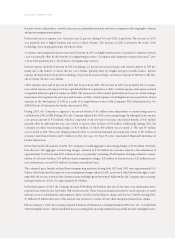American Express 2003 Annual Report Download - page 35
Download and view the complete annual report
Please find page 35 of the 2003 American Express annual report below. You can navigate through the pages in the report by either clicking on the pages listed below, or by using the keyword search tool below to find specific information within the annual report.
The following table presents the impact to net income and EPS of goodwill amortization for the year ended December 31, 2001:
(Millions, except per share amounts) Net Income Basic EPS Diluted EPS
Reported $1,311 $ 0.99 $ 0.98
Add back: Goodwill amortization (after-tax) 82 0.06 0.06
Adjusted $1,393 $ 1.05 $ 1.04
Certain Critical Accounting Policies
The Company’s significant accounting policies are described in Note 1 to the Consolidated Financial Statements. The fol-
lowing provides information about certain critical accounting policies that are important to the Consolidated Financial
Statements and that involve estimates requiring significant management assumptions and judgments about the effect of
matters that are uncertain. These policies relate to reserves for cardmember credit losses, Membership Rewards costs, invest-
ment securities valuation and deferred acquisition costs.
Reserves for cardmember credit losses
The Company’s reserves for credit losses relating to cardmember loans and receivables represent management’s estimate of
the amount necessary to absorb future credit losses inherent in the Company’s outstanding portfolio of loans and receiv-
ables. Management’s evaluation process requires many estimates and judgments. Reserves for these credit losses are pri-
marily based upon models that analyze specific portfolio statistics and also reflect, to a lesser extent, management’s
judgment regarding overall adequacy. The analytic models take into account several factors, including average write-off rates
for various stages of receivable aging (i.e., current, 30 days, 60 days, 90 days) over a 24-month period and average bank-
ruptcy and recovery rates. In exercising its judgment to adjust reserves that are calculated by the analytic model, manage-
ment considers the level of coverage of past-due accounts, as well as external indicators, such as leading economic indicators,
unemployment rate, consumer confidence index, purchasing manager’s index, bankruptcy filings and the regulatory envi-
ronment. Management believes the impact of each of these indicators can change from time to time and thus reviews these
indicators in concert.
Loans are charged-off when management deems amounts to be uncollectible, which is generally determined by the num-
ber of days past due. In general, bankruptcy and deceased accounts are written-off upon notification, or when 180 days
past due for lending products and 360 days past due for charge card products. For all other accounts, write-off policy is
based upon the delinquency and product. Given both the size and volatility of write-offs, management continually moni-
tors evolving trends and adjusts its business strategy accordingly. To the extent historic credit experience is not indicative
of future performance or other assumptions used by management do not prevail, loss experience could differ significantly,
resulting in either higher or lower future provisions for credit losses, as applicable. As of December 31, 2003, if average write-
off rates were 5% higher or lower, the reserve for credit losses would change by approximately $100 million.
Membership Rewards costs
The Company’s Membership Rewards loyalty program allows enrolled cardmembers to earn points that can be redeemed
for a broad range of travel rewards, retail merchandise and gourmet gifts. The Company makes payments to its reward part-
ners when cardmembers redeem their points and establishes reserves to cover the cost of future reward redemptions. The
provision for the cost of Membership Rewards is based upon points awarded that are ultimately expected to be redeemed
by cardmembers and the current weighted-average cost per point of redemption. The ultimate points to be redeemed are
estimated based on many factors, including a review of past behavior of cardmembers segmented by product, year of enroll-
ment in the program, spend level and duration in the program. Past behavior is used to predict when current enrollees will
attrite and their ultimate redemption rate. The weighted-average cost per point is affected by the mix of redemptions.
(p.33_axp_ financial review)
























